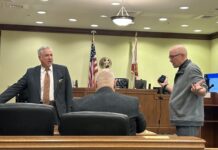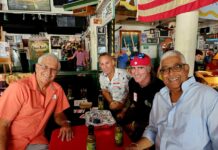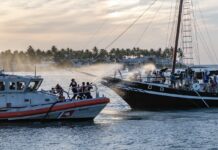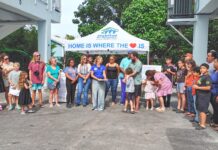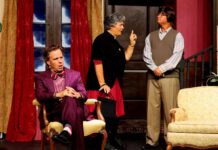
Knights Key is found at the foot of the Seven Mile Bridge in the Middle Keys and is included under the Marathon umbrella. Not everyone is as aware of Knights Key’s rich railroad history — which is tremendous.
Nearby Pigeon Key attracts a great deal of the Middle Key’s attention when it comes to the train that used to rock, roll and steam up and down the Florida Keys. Pigeon Key served as a base of operations during the construction of the railroad bridges connecting Marathon to the Lower Keys — among other projects — and is a great place to visit to learn more about the railroad’s history.
While Key West was the southernmost terminus for the Over-Sea Railroad, it was not the first last stop on the Key West Extension of Henry Flagler’s Florida East Coast Railway. Before the train roared down the tracks and all the way to Key West, the line’s terminus was Knights Key or, more precisely, at the long railroad trestle bridge and wharf extending out over the shallows of the clear Atlantic waters off of Knights Key.
What might be surprising to learn about the island is that it was being used as farmland long before Flagler and his train arrived. The Charleston Daily Courier of Jan. 10, 1858, described Knights Key: “…containing about one hundred and twenty-five acres of arable land, and has a comfortable house and cistern. On this Key we have twelve hundred cocoanut trees and about fifty thousand Sisal hemp plants, most of which are fit to cut and manufacture into hemp…”
Farming was not isolated to Knights Key or the Middle Keys but was a primary industry, especially for those hardy pioneers scratching out a way of life for their families up and down a then-isolated string of islands. In addition to coconuts and sisal agave, pineapples, limes, tomatoes, melons, cucumbers and onions were important cash crops.
Before Flagler’s train reached Miami in 1896, farmers sent the fruits of their labor through the shipping channels. Once the train arrived, first to Miami and next to the Keys, farmers could more efficiently get their product to east coast markets like New York, Boston and Philadelphia.
Just after the turn of the century, railroad workers began laying tracks and building the bridges necessary to connect the islands from one to another. Progress linking the Upper Keys to the Middle Keys was quicker than the heroic efforts being made to make all the connections required to reach Key West. From a newspaper clipping dated April 28, 1906: “A large number of workmen are now at work at Knights Key. They will build warehouses and docks there with the intention of making the Key a supply station. A large cistern and the big buildings are already on the Key and lumber and material for the other work is being hauled there in large quantities. The docks will be built on the west side and extend out to the 25-foot channel for the accommodation of deep draught vessels.”
The Knights Key dock and wharf were connected to the island by a wooden trestle bridge. The development of the project was documented in a story printed in the Florida Times-Union on Dec. 18, 1906: “Because of the large number of vessels visiting Knights Key with materials for the railroad extension work, the Key has recently been made a port of entry with Dr. Cotton as deputy inspector.”
The railroad tracks bridging the train depot in Miami to the trestle bridge and wharf extending into the Atlantic Ocean from Knights Key were completed circa Christmas Day 1907. When it was completed, the Knights Key dock stretched 4,000 feet into the Atlantic. No small endeavor, enough pilings and planks were used to support two warehouses, an office and depot building, and two sets of railroad tracks. The dock was additionally able to accommodate two steamers at a time.
At some point during the first week of January, the Florida East Coast Railway extended daily railroad service to the dock at Knights Key. Two trains heading to the Keys left the Miami depot every morning, one at 6:30 a.m. and one at 11 a.m. The 11 o’clock run from Miami to the Knights Key dock connected with a steamer running between Key West and Havana. Also, two trains rolled off the dock every morning, up the Keys, and stopped at Miami — the first left at 5:40 a.m. and the second at 10 a.m.
Improvements continued to occur. On May 27, 1908, a post office and telegraph station began operating. The Knights Key dock, however, was not built to last. Its purpose was to serve as a temporary terminus for the Key West Extension while the bridges and tracks connecting the railroad to Key West were completed. When they were, and the southernmost depot was established, the dock up in the Middle Keys became obsolete.
The temporary terminus that operated from 1908-1912 is often missing from discussions about the Over-Sea Railroad. The primary focus is Flagler’s arrival on the island, when his private railcar, the Flagler Special, rattled and rolled over Key West on Jan. 22, 1912. Significant fanfare celebrating the event has been reported.
With the Knights Key dock no longer functioning or necessary, it was broken down. On Jan. 30, 1912, the Knights Key Post Office closed, and the mail was rerouted to the Marathon Post Office. The rest, as they say, is history.
